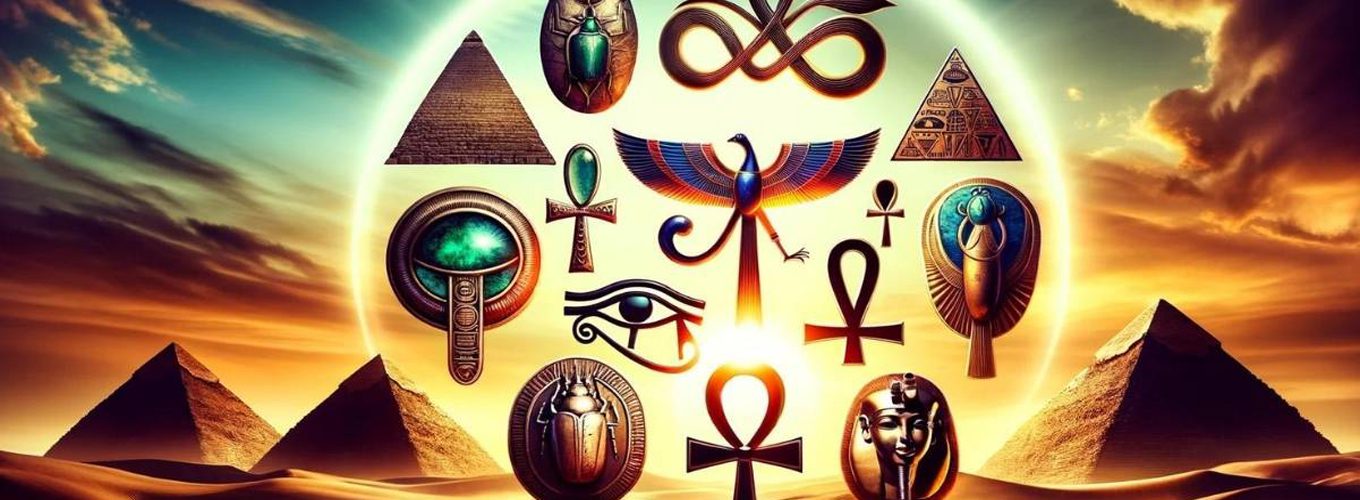In the mystical lands of ancient Egypt, where the sands whisper secrets of bygone eras, Egyptian Symbols of Protection held immense power and significance. From the enigmatic Eye of Horus to the sacred Ankh, these symbols were more than mere art; they were believed to safeguard the soul and body against harm.
Whether you’re a history enthusiast, a spiritual seeker, or simply curious about the enigmatic world of Egyptian mythology, this exploration of Egyptian symbols of protection will captivate your imagination and provide a deeper understanding of how these ancient icons continue to inspire and protect in modern times.
Journey with us through the annals of time as we unravel the fascinating stories behind these powerful emblems.
Discover Egypt and Know More About ancient Egypt history

1- The Ankh: Egyptian Protection Symbols
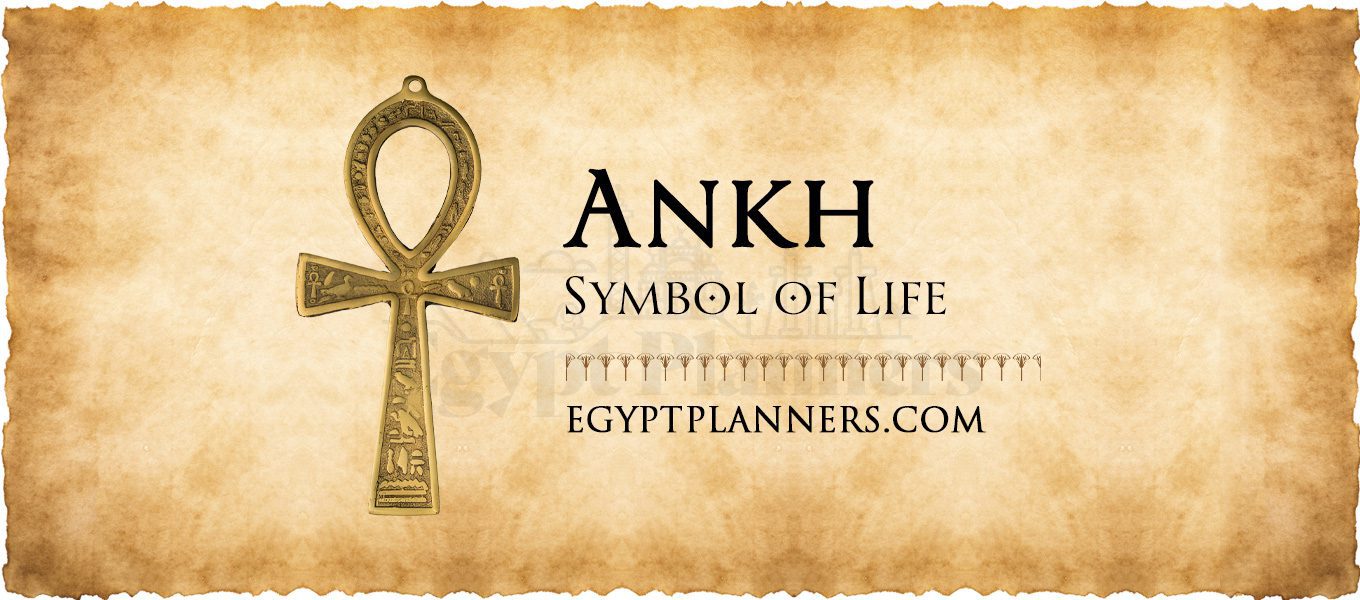
The Ankh, often referred to as the key of life, stands as one of the most iconic and widely recognized symbols of ancient Egypt. This cross-like emblem, with a loop at the top, transcends mere decoration, embodying the concept of eternal life and the unification of masculine and feminine principles. It was commonly depicted in the hands of deities or pharaohs, symbolizing their power to bestow life or prosperity. Beyond its spiritual significance, the Ankh serves as a reminder of the ancient Egyptians’ quest for understanding the mysteries of life and the afterlife.
2- The Djed: Egyptian Symbol of Protection

Symbolizing stability, durability, and resilience, the Djed pillar is one of ancient Egypt’s most profound symbols of protection. Often interpreted as the backbone of the god Osiris, it represents strength and the continuation of life, playing a pivotal role in ceremonies aimed at rejuvenating the pharaoh’s strength. The Djed’s depiction in various artifacts, from amulets to temple walls, underscores its significance in ensuring the cosmic order and the well-being of the state and its inhabitants.
3- The Was Scepter: Egyptian Symbols Protection
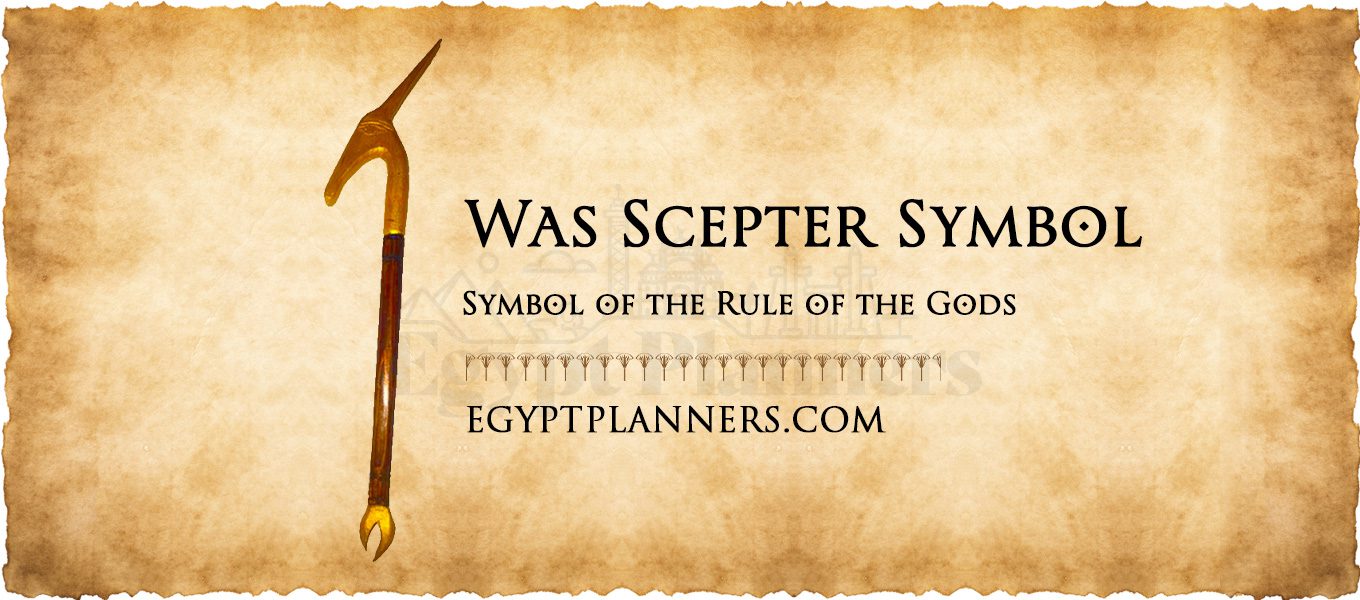
The Was Scepter, a symbol of power and dominion, features prominently in the iconography of ancient Egypt. Characterized by its distinctive animal-headed top and forked base, it was not merely a ceremonial object but a potent emblem of authority wielded by gods, kings, and priests. This scepter underscores the complex relationship between the spiritual and temporal realms in Egyptian culture, representing control over chaos and the assurance of order. Its symbolic presence across various mediums provides a fascinating glimpse into the ancient Egyptians’ societal structure and their profound respect for the forces governing life and the afterlife. For scholars and Egyptophiles, the Was Scepter embodies the essence of ancient Egyptian civilization’s enduring legacy of power, protection, and divine right.
4- The Scarab: Egyptian Protection Symbol
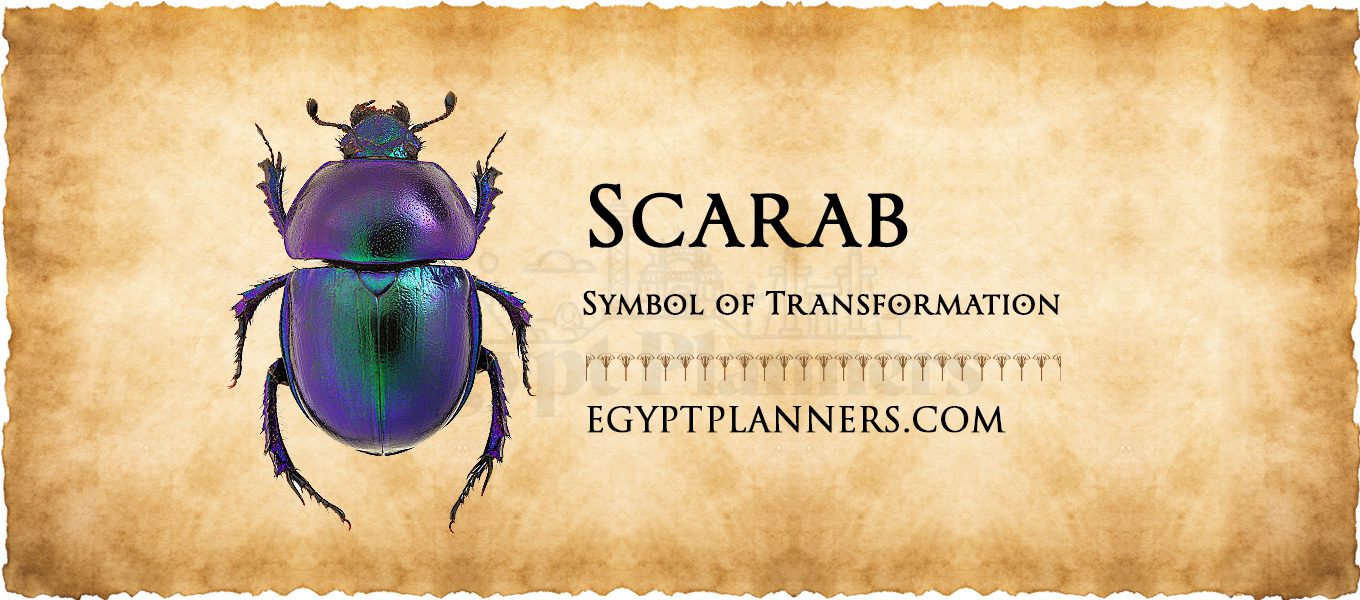
The Scarab beetle, embodying rebirth and regeneration, is a potent symbol of protection in ancient Egyptian culture. This emblem, often crafted into amulets and jewelry, was believed to safeguard the wearer against evil and guide them through the afterlife’s perilous journey. The scarab’s significance is rooted in its natural behavior; the dung beetle rolls dung into a ball, mirroring the sun’s journey across the sky, a process ancient Egyptians associated with the cycle of life and rebirth. The Scarab’s widespread depiction in tomb paintings, scriptures, and artifacts underscores its role in promoting renewal and eternal life.
5- The Tjet (Tyet): Egyptian Symbols of Protection

The Tjet, often paired with the Ankh, represents life and welfare and is considered a symbol of protection, particularly for women and goddesses. Resembling a knot or a girdle, it is associated with Isis, the goddess of magic, marriage, healing, and protection. This symbol served as an amulet of protection, believed to wield the power to ward off evil and bring about health and safety to its bearer. The Tjet’s presence in jewelry, amulets, and funerary artifacts speaks to its integral role in ancient Egyptian daily and spiritual life. Its significance extends beyond mere adornment, offering insights into the societal and religious practices that revered the divine feminine power.
6- The Lotus: Egyptian Symbols for Protection
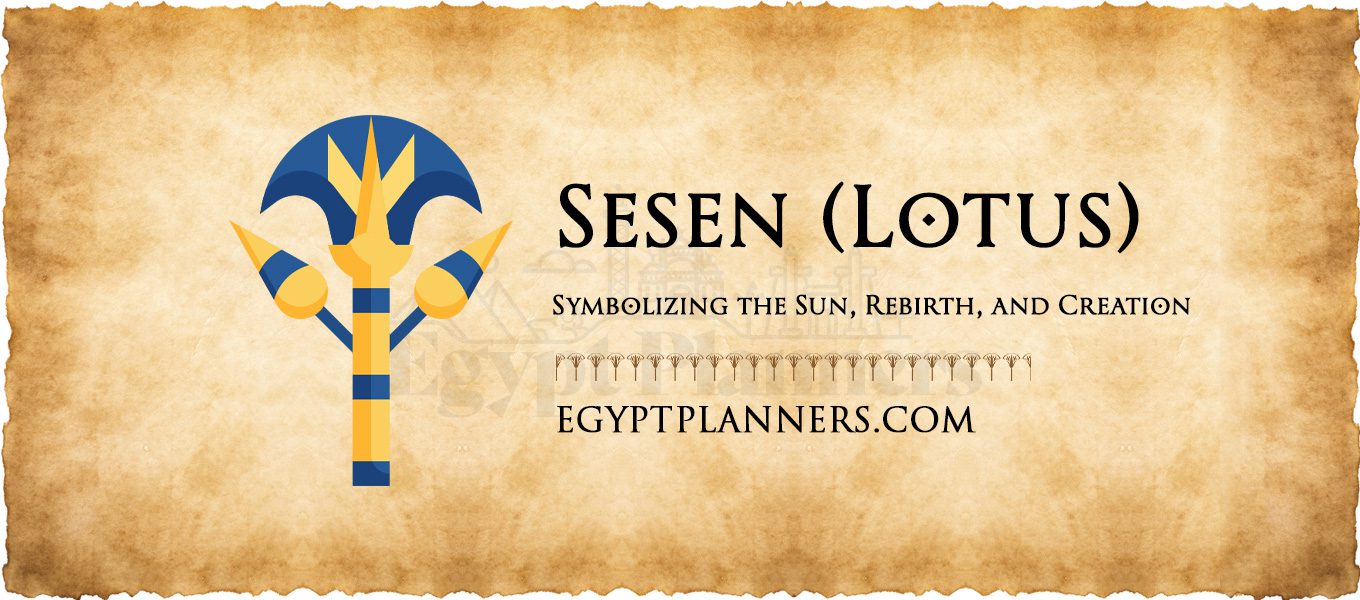
In ancient Egyptian culture, the Lotus flower stands as a symbol of purity, creation, and rebirth. Emerging from murky waters each morning to bloom anew, it represented the sun’s resurrection and, by extension, the rebirth of individuals in the afterlife. The Lotus was intimately linked to the sun god Ra and the concept of eternal life, often depicted in art and literature sprouting from the body of deities, signifying the soul’s emergence into the afterlife. Its imagery in tombs, temples, and papyri served not only as a protective emblem but also as a reminder of life’s beauty, resilience, and potential for renewal amidst adversity. The Lotus continues to captivate those interested in Egyptology, symbolizing the ancient Egyptians’ profound connection to nature and their deep-seated beliefs in the cyclical nature of life and the promise of rebirth.
Learn about the best packages you can book with Egypt Planners and get a special discount
- 7 Day Cairo With Nile Cruise Tour Package
- 8 Days Cairo With 3 Nights Nile Cruise By Flight
- 8 Days Cairo And 4 Nights Cruise With Abu Simbel By Flight
- 10 Day Cairo, Alexandria And Nile Cruise With Abu Simbel By Flight
- 11 Day Cairo & Nile Cruise And Hurghada
- 14 Day Cairo & Alexandria & Nile Cruise And Hurghada
7- The Shen: Egyptian Symbol for Protection
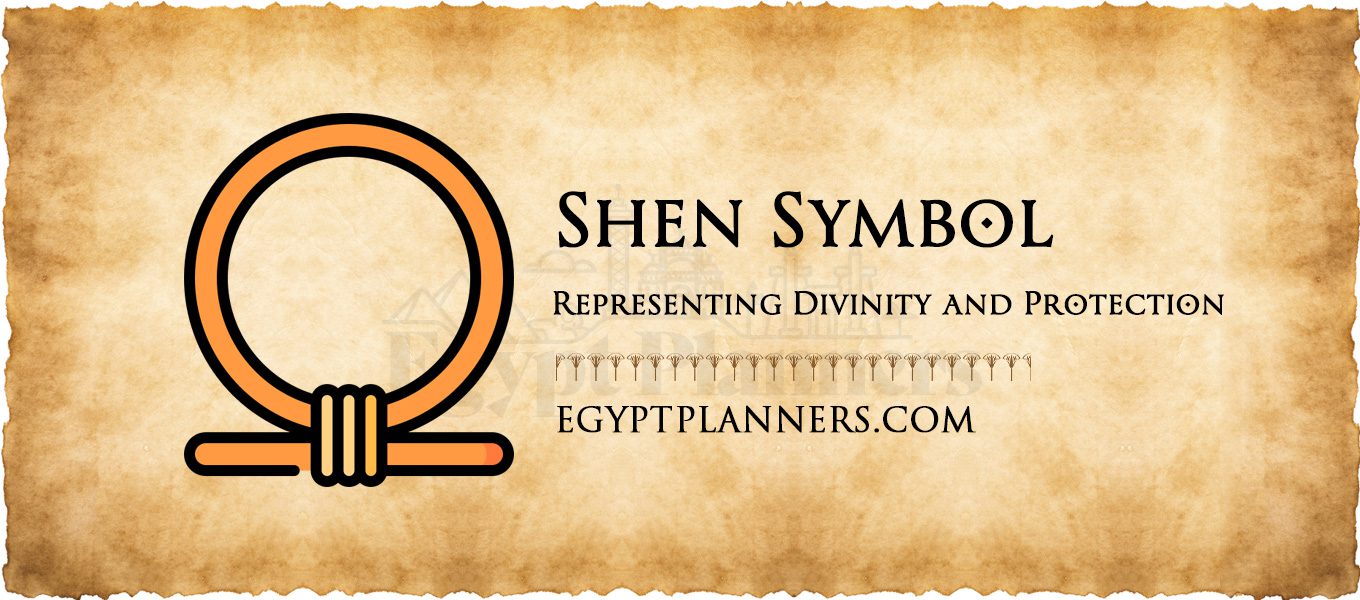
The Shen symbol, often depicted as a looped rope with no beginning or end, represents eternity, protection, and the cyclical nature of the universe. Worn as an amulet or inscribed in royal and divine insignias, it offered a protective embrace to the wearer or the object it encircled, ensuring their safety and longevity. The Shen’s infinite loop was a powerful reminder of the eternal nature of the soul and the universe’s perpetual cycles, echoing the ancient Egyptians’ deep understanding of time and existence. Its appearance in various forms of art and artifacts reflects its significance in conveying the message of eternal protection and the unending cycle of life, death, and rebirth.
8- Wadjet, The Eye of Horus: Egyptian Symbol Protection
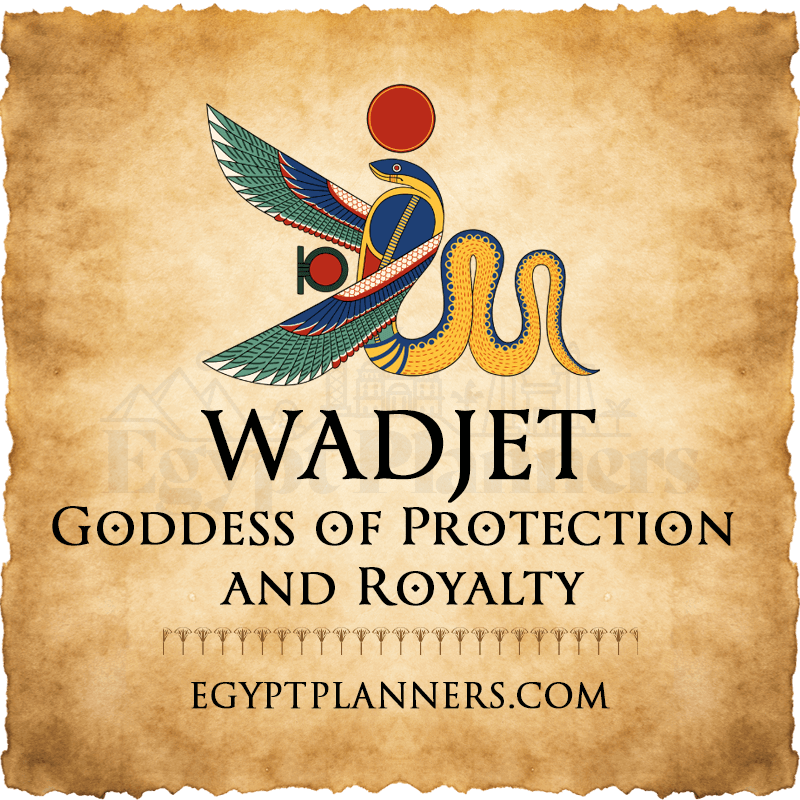
The Eye of Horus, also known as Wadjet, is a symbol deeply embedded in the mythology and art of ancient Egypt, representing healing, protection, and restoration. According to myth, Horus, the sky god, lost his eye in a fierce battle with Seth, only for it to be restored, symbolizing the process of making whole what has been lost or damaged. This powerful emblem was used in amulets and talismans to ward off evil, promote healing, and ensure the safety and health of the bearer. The Eye of Horus’s widespread depiction across various mediums underscores its importance in offering protection in both the physical and spiritual realms.
9- Eye Of Ra: Ancient Egyptian Protection Symbols
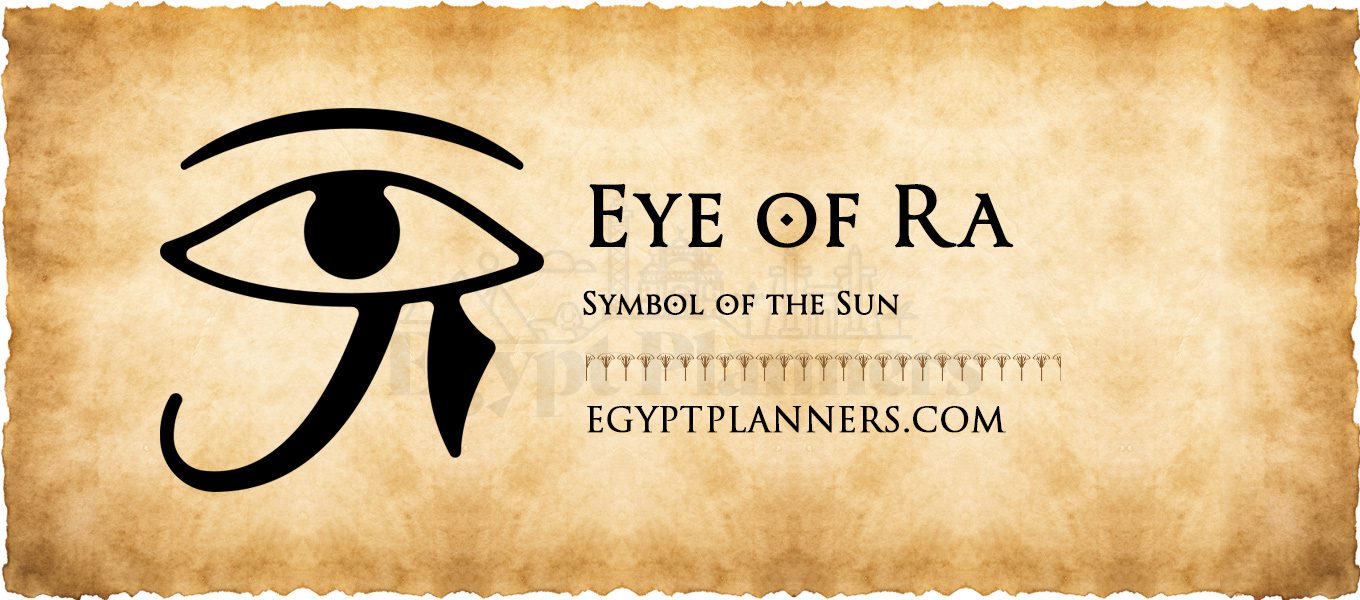
Similar to the Eye of Horus, the Eye of Ra is a significant protective symbol in ancient Egyptian mythology, representing the power and wrath of the sun god Ra. This emblem embodies the feminine counterpart to Ra, often associated with the goddesses Hathor, Sekhmet, and Bastet, who could manifest as the protective lioness or the nurturing cow. The Eye of Ra was believed to combat chaos and disorder, safeguarding the order of the universe and the well-being of people. Its depiction in art and artifacts serves as a testament to the ancient Egyptians’ reverence for the sun’s life-giving and protective powers.
10- Hekha and Nekhakha: Egyptian Sign for Protection
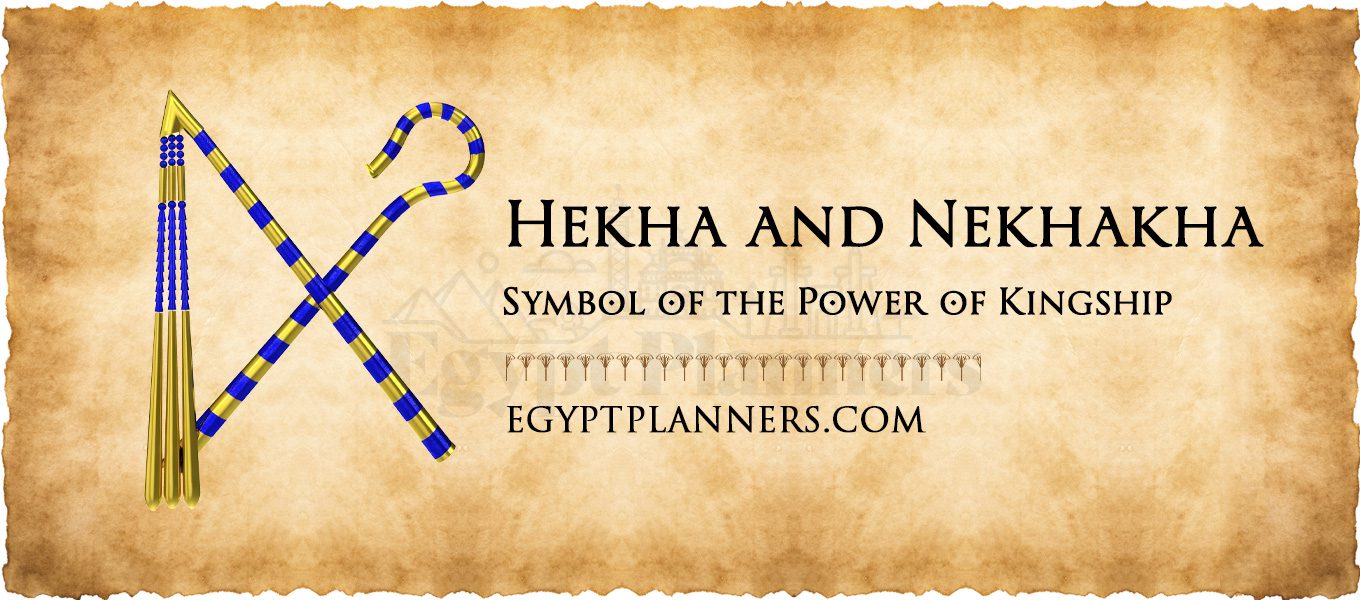
The Hekha and Nekhakha symbols represent royal authority and divine power in ancient Egypt, often seen in depictions of pharaohs and deities. The Hekha, a crook, symbolizes the pharaoh’s role as the shepherd of his people, guiding and protecting them. The Nekhakha, a flail, represents the fertility of the land, a critical aspect of the king’s duty to ensure prosperity and well-being. Together, these symbols underscore the pharaoh’s dual role as both a temporal leader and a divine intermediary, responsible for maintaining Ma’at, or cosmic order. Their presence in regalia and state iconography highlights the central importance of the pharaoh in Egyptian society and the complex ideology that supported his rule. For modern observers, Hekha and Nekhakha offer a window into the ancient Egyptians’ political and spiritual life, reflecting the intertwined nature of authority and divinity in this ancient civilization.
11- Ouroboros: Egypt Protection Symbol
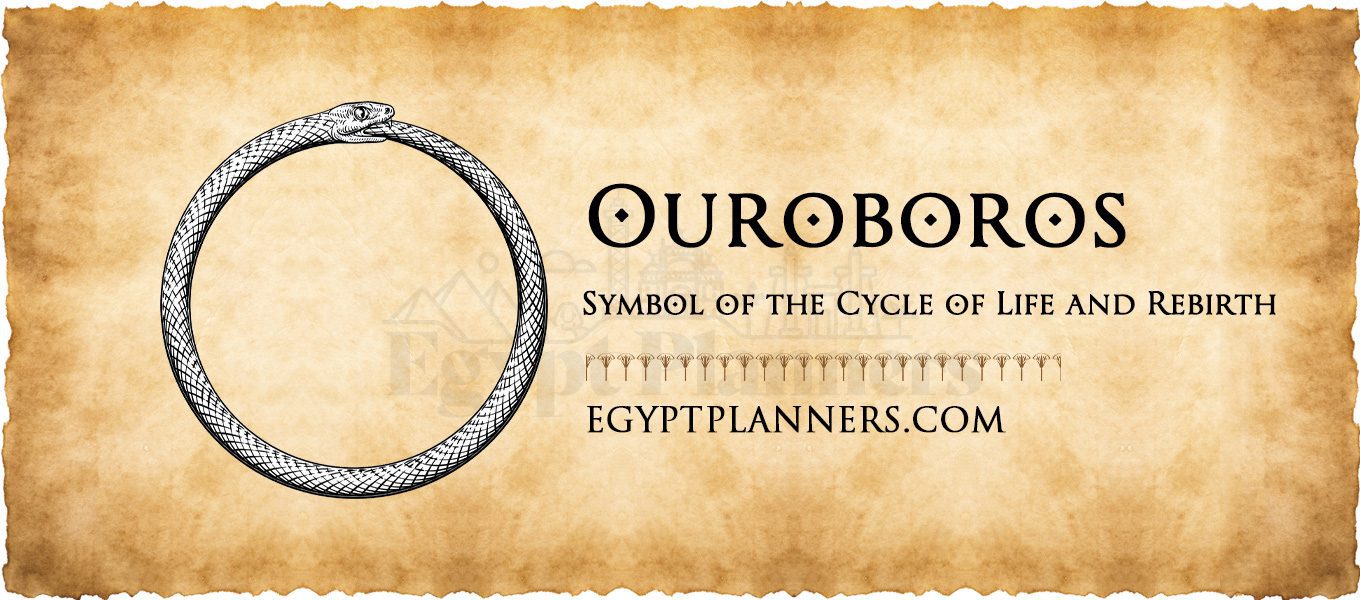
The Ouroboros, depicting a serpent eating its tail, is an ancient symbol that transcends Egyptian culture, embodying the concepts of eternity, cyclicality, and the perpetual renewal of life. In Egyptian iconography, it represents the endless cycle of life, death, and rebirth, and the unity of time’s beginning and end. This symbol was often associated with the underworld and the sun’s journey through the night, reflecting the ancient Egyptians’ deep engagement with the mysteries of life and the afterlife. The Ouroboros’s enduring appeal lies in its simplicity and the profound truths it symbolizes about the universe’s nature.
12- Cartouche: Protection Hieroglyph

The Cartouche, an oval with a horizontal line at one end, encircles the names of pharaohs and royal individuals in hieroglyphs, symbolizing their protection from evil spirits in life and death. This emblematic rope loop represents the universe’s infinite cycle, encapsulating the king’s or queen’s name within its protective embrace. The Cartouche underscores the sanctity and power of the royal name, elevating the bearer above mere mortals. Its use in jewelry, tombs, and monuments speaks to its role in ancient Egyptian culture as a potent symbol of royal authority and divine protection.
13- Uraeus Symbol: Egyptian Protection Symbols
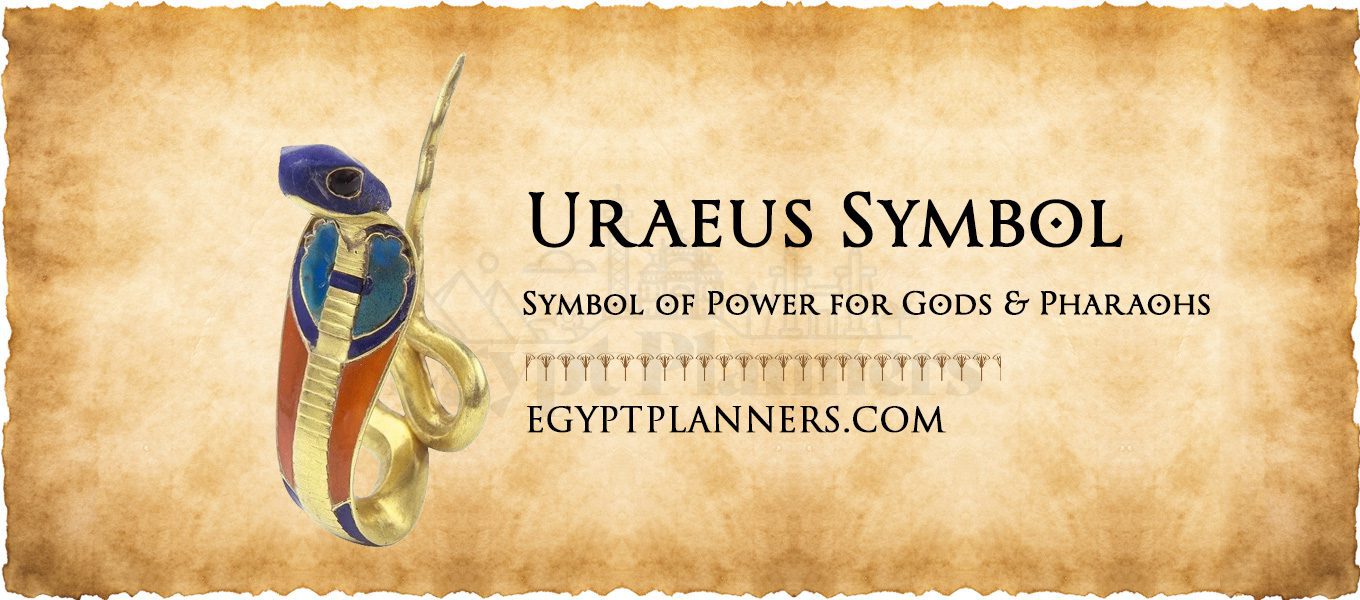
The Uraeus, depicting a rearing cobra, is a symbol of sovereignty, royalty, and divine authority in ancient Egypt. This powerful emblem, often worn on the crowns of pharaohs and deities, served as a protector against enemies and a marker of the ruler’s supreme power. The cobra is associated with the goddess Wadjet, one of the oldest Egyptian deities, who embodies the land’s fertility and the kings’ protector. The Uraeus stands as a testament to the ancient Egyptians’ reverence for the natural world and its creatures, imbuing them with divine significance.
14- KA Symbol: Egyptian Symbol of Protection

The KA symbol represents the vital essence or spirit of an individual in ancient Egyptian belief. This concept is crucial to understanding the Egyptians’ views on the afterlife and the importance of preserving the body through mummification. The KA was thought to live on after the physical body had died, requiring sustenance and care to ensure its survival in the next world. Artifacts and tomb paintings often depict offerings made to the KA, emphasizing its significance in the journey beyond death. The KA symbolizes the complex interplay between life, death, and eternity in ancient Egyptian culture, offering a fascinating perspective on their profound spiritual and philosophical understanding of human existence.
15- BA Symbol: Egyptian Symbols Protection

The BA, often represented as a human-headed bird, embodies the concept of personality or soul in ancient Egyptian thought. Unlike the KA, which stays in the tomb, the BA was believed to fly freely between the underworld and the living world, acting as a link between the deceased and their earthly life. The depiction of the BA in tomb paintings and funerary texts highlights its role in the afterlife, navigating the deceased’s journey and participating in the cycle of rebirth. The BA’s significance lies in its reflection of the ancient Egyptians’ nuanced beliefs about identity, consciousness, and the afterlife, offering a window into their intricate understanding of the soul’s journey after death.
16- Canopic Jars of Ancient Egypt: Egyptian Protection Symbol
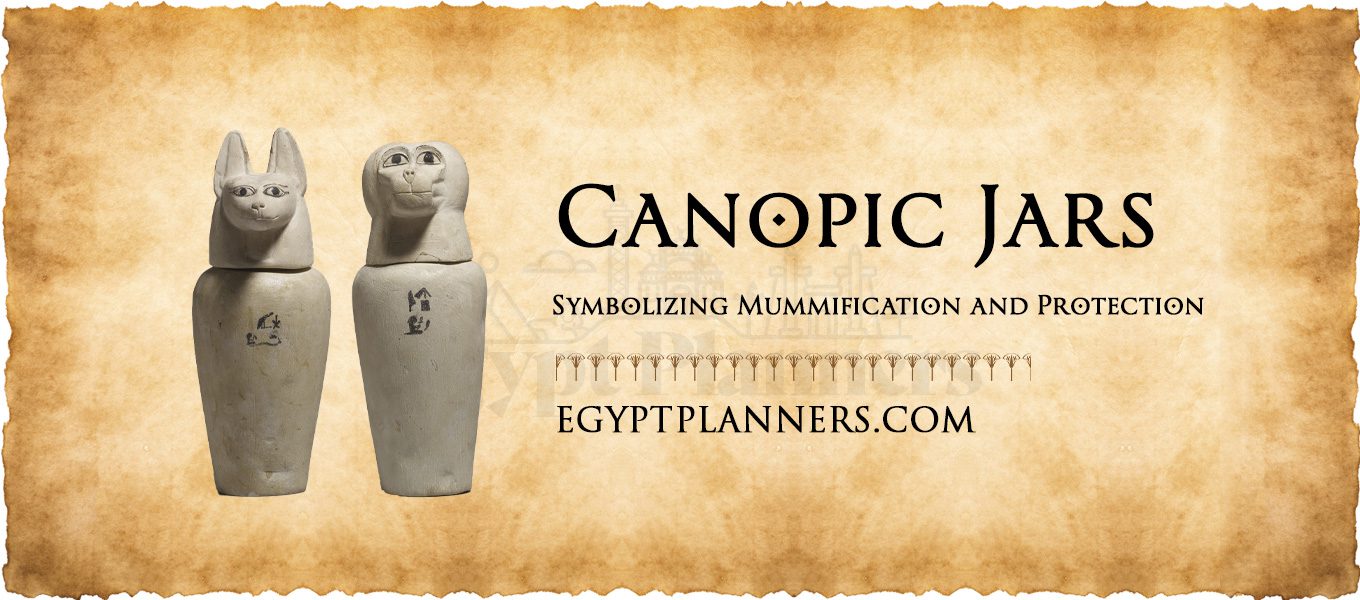
Canopic jars played a vital role in the mummification process in ancient Egypt, serving as containers for the internal organs removed from the body during embalming. Each jar, dedicated to one of the Four Sons of Horus, protected the liver, lungs, stomach, and intestines, ensuring their safety for the afterlife. The jars’ designs, often featuring the heads of the protective deities, underscored the Egyptians’ belief in the afterlife’s importance and their meticulous care for the dead. Canopic jars not only reveal the sophistication of ancient Egyptian funerary practices but also their deep-rooted beliefs in resurrection and eternal life, captivating those who seek to understand the rituals that prepared souls for the journey beyond.
17- Egyptian Winged Sun: Egyptian Symbols of Protection
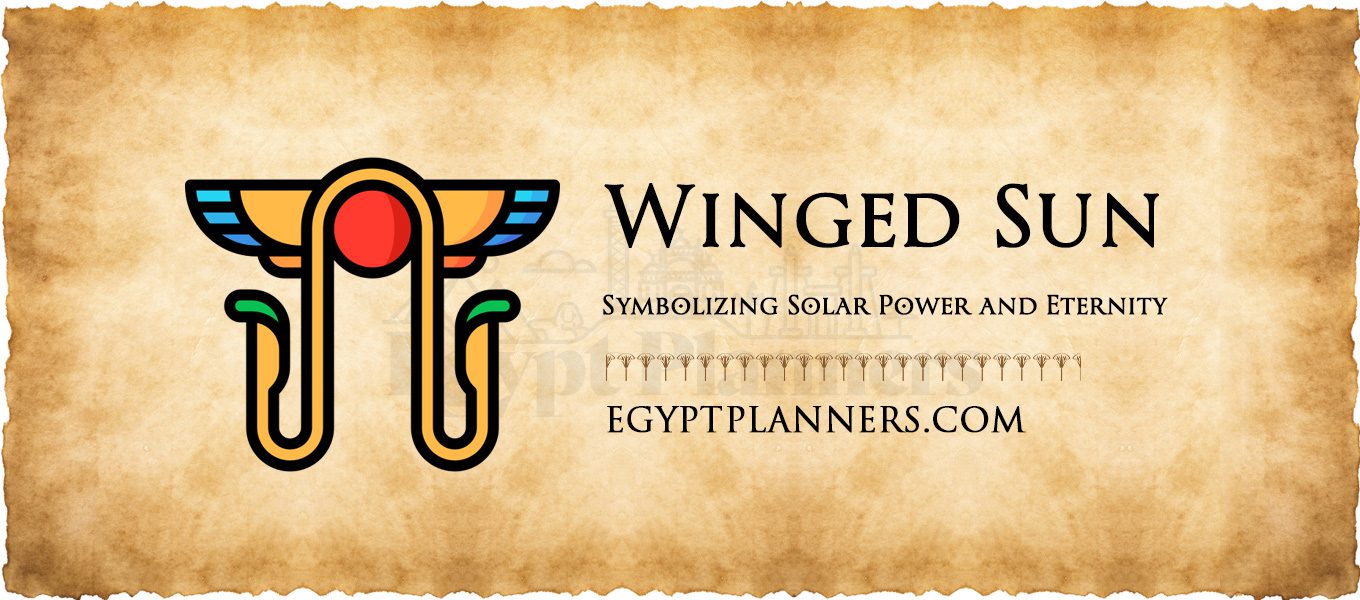
The Egyptian Winged Sun is a symbol of protection, power, and royal authority, representing the sun god Ra’s omnipresence and the horizon from which the sun rises and sets. This emblem, featuring a sun disk flanked by two outstretched wings, adorned temples, tombs, and monuments, symbolizing the divine protection over the land and its people. The Winged Sun speaks to the ancient Egyptians’ reverence for the sun as a source of life and a protector against chaos, embodying their cosmological views and religious fervor. Its enduring presence in Egyptian iconography continues to inspire awe and wonder, highlighting the civilization’s deep connection to the natural world and the divine forces governing it.
18- Amenta Symbol: Egyptian Symbols for Protection
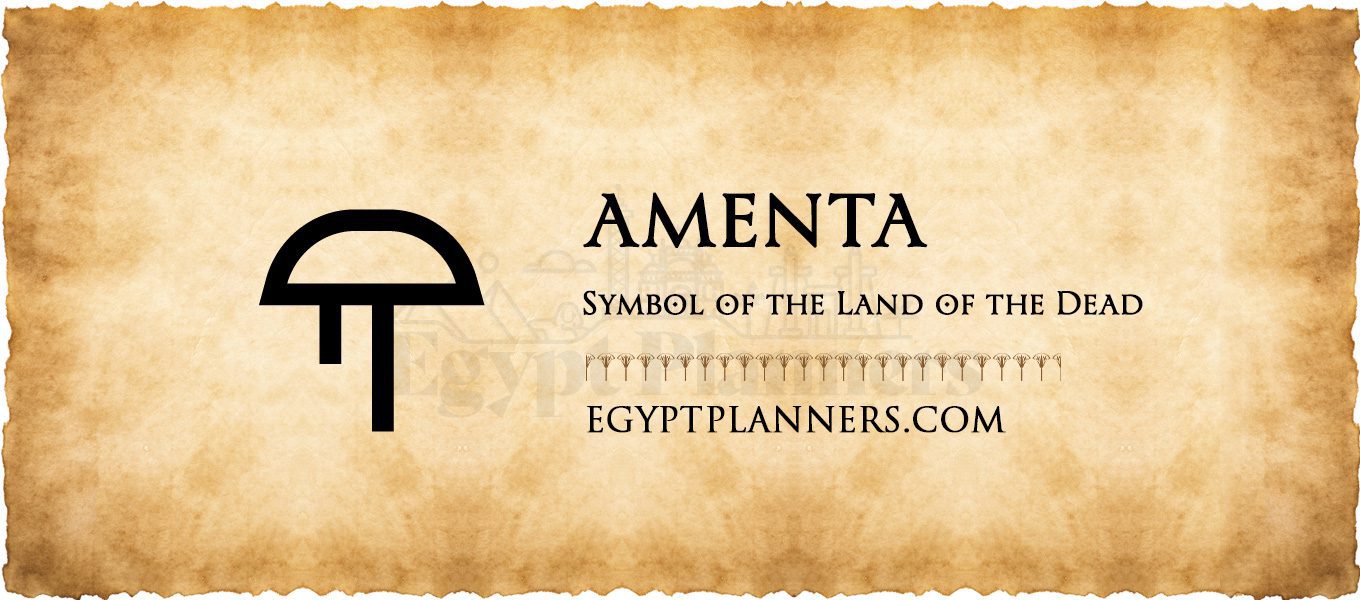
Amenta symbolizes the underworld or the land of the dead in ancient Egyptian belief. This term encapsulates the Egyptians’ conception of the afterlife as a fertile, Nile-like realm where souls would dwell after death, provided they passed the judgment of Osiris. Amenta was more than a place of rest for the dead; it was a reflection of the Egyptians’ intricate beliefs about death, rebirth, and the afterlife’s eternal life. Artifacts and texts depicting scenes of Amenta offer insights into the rituals, gods, and moral code that guided the deceased’s journey, revealing the ancient Egyptians’ profound engagement with the mysteries of life and death.
19- Feather Of Maat: Egyptian Symbol for Protection
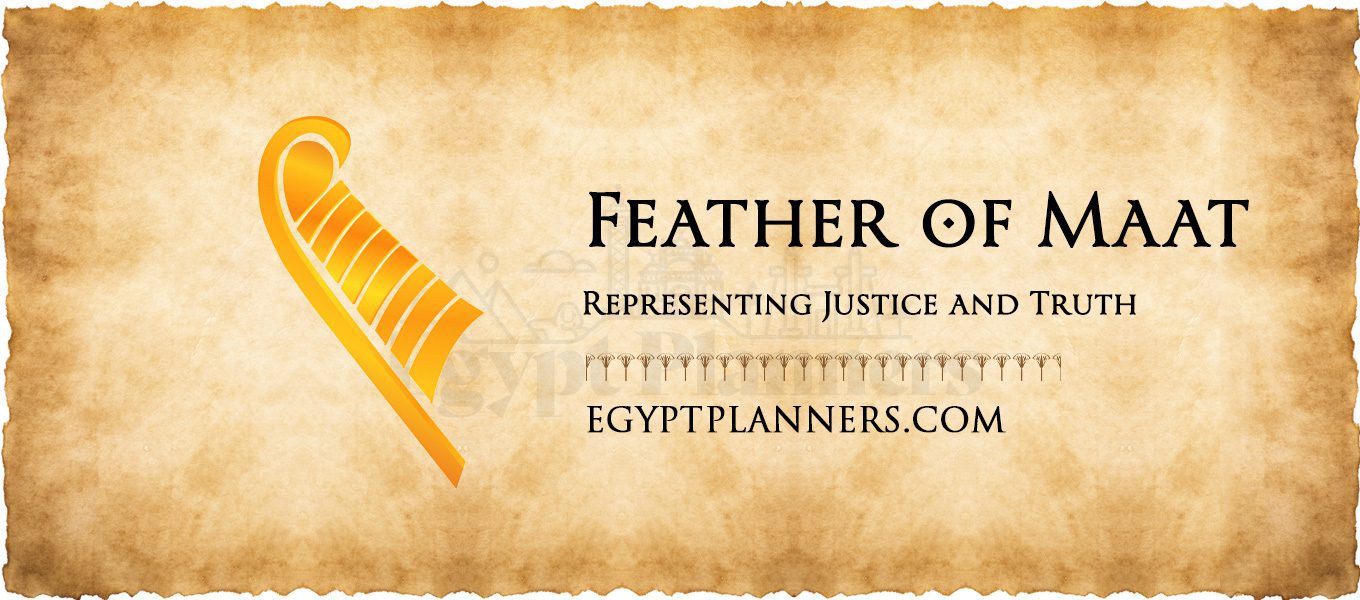
The Feather of Maat, representing truth, justice, and cosmic order, was central to ancient Egyptian religion and philosophy. Maat, the goddess embodying these principles, played a crucial role in the afterlife judgment process, where the heart of the deceased was weighed against her feather. If the heart was lighter or equal in weight, it indicated a life lived in harmony with Maat’s laws, granting the soul passage to the afterlife. The Feather of Maat symbolizes the ancient Egyptians’ deep commitment to balance, morality, and the ethical conduct of life, influencing not only their spiritual beliefs but also their societal structures. This symbol continues to resonate with those exploring
20- Deshret Crown: Egyptian Symbol Protection

The Deshret Crown, also known as the Red Crown, symbolizes Lower Egypt’s (the northern region’s) sovereignty. This distinctive red-hued crown was one of ancient Egypt’s earliest symbols of kingship, representing the ruler’s control over the Nile Delta. The Deshret Crown, often seen in depictions of pharaohs and gods associated with Lower Egypt, underscores the ancient civilization’s dual monarchy concept before its unification under a single crown. Its significance extends beyond mere regalia, embodying the fertile lands and the life-giving waters of the Nile that were crucial for the civilization’s sustenance and prosperity.
21- Hedjet Crown: Ancient Egyptian Protection Symbols

The Hedjet Crown, or White Crown, is emblematic of Upper Egypt’s (the southern region’s) kingship and divine authority. This tall, white, conical crown was more than a royal accessory; it signified the pharaoh’s rule over the land of the sedge, contrasting with the Deshret Crown of Lower Egypt. The Hedjet Crown’s presence in art and iconography reflects the ancient Egyptians’ deep-seated beliefs in the divine right of pharaohs and their connection to the gods. The unification of Upper and Lower Egypt is a pivotal moment in the country’s history, with the Hedjet Crown playing a central role in symbolizing the pharaohs’ sovereignty and divine mandate over the unified kingdom.
22- Pschent Crown: Egypt Protection Symbol

The Pschent Crown, a fusion of the Deshret and Hedjet crowns of Lower and Upper Egypt, respectively, symbolizes the pharaoh’s dominion over the unified Egypt. This double crown, combining the red and white of the two regions, became a powerful emblem of the pharaoh’s supreme authority and the nation’s unity. Its appearance in royal iconography and depictions of the gods underscores the significance of the pharaoh as a unifier and a divine intermediary.
23- Tree of Life Symbol: Protection Hieroglyph
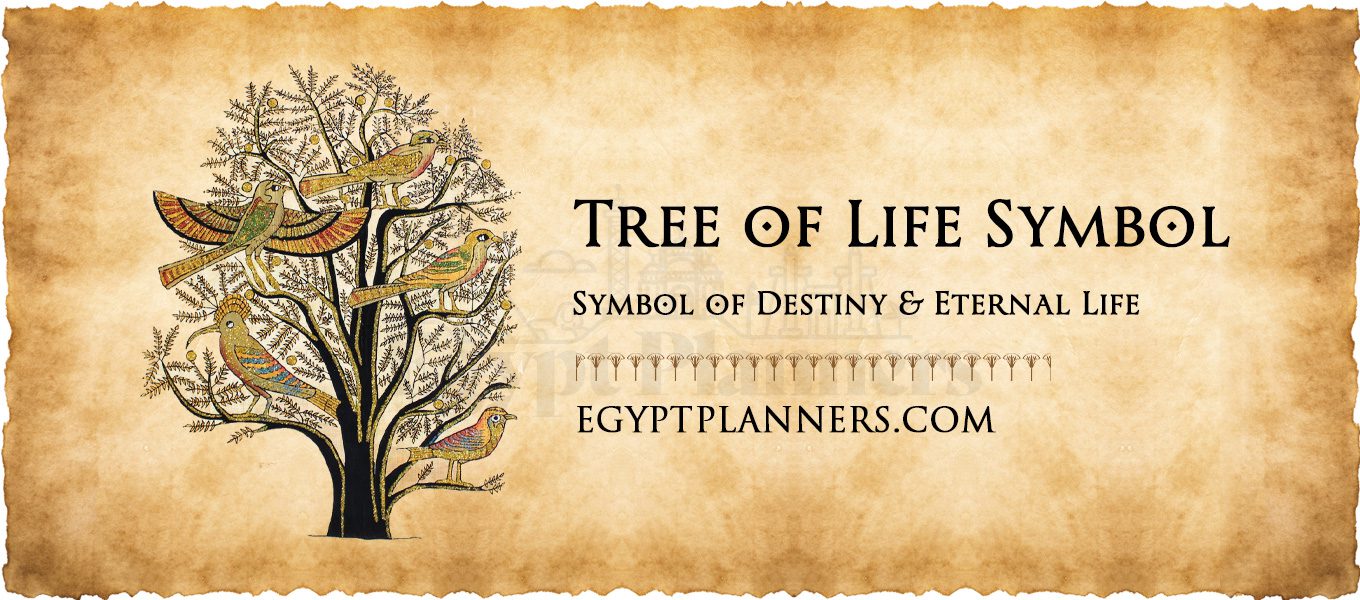
The Tree of Life in ancient Egyptian mythology is not only a symbol of life and abundance but also of the interconnectedness of all forms of creation. Often depicted with the god Osiris or the goddess Isis, the Tree of Life represents eternal life and regeneration. This motif, found in tombs and temples, illustrates the Egyptians’ belief in the afterlife and the cyclical nature of existence, from death to rebirth. The Tree of Life’s enduring appeal lies in its representation of the fundamental unity of life, offering insights into the ancient Egyptians’ worldview and their profound connection to the natural world.
24- Seba Symbol: Egyptian Protection Symbols

The Seba, or star symbol, was integral to ancient Egyptian cosmology and religion, representing the celestial aspect of their spirituality. Stars were thought to be the souls of the deceased, ascending to the heavens to live eternally among the gods. This symbolism is evident in the decoration of tombs and temples, where stars adorn ceilings, representing the night sky. The Seba symbolizes the Egyptians’ fascination with astronomy and their belief in a life beyond death, resonating with modern explorations into the mysteries of the universe and our place within it.
25- Ajet: Egyptian Symbol of Protection
The Ajet symbol, representing the horizon from which the sun rises and sets, signifies the cycle of rebirth and renewal. This emblem encapsulates the ancient Egyptians’ deep connection with the sun and its daily journey across the sky, mirroring the journey of life, death, and rebirth. The Ajet is often associated with the god Horus and the solar deity Ra, symbolizing the eternal struggle between order and chaos, light and darkness. Its representation in art and architecture reflects the civilization’s cosmological beliefs and their reverence for the natural cycles that govern existence.
26- Menat: Egyptian Symbols Protection

The Menat, a type of ritual necklace, served as a symbol of fertility, protection, and divine favor in ancient Egypt. Often associated with the goddess Hathor, the Menat was used in ceremonies and was believed to convey her blessings of joy, fertility, and protection against evil. This artifact, frequently depicted in the hands of deities or worn by dancers and musicians, underscores the interconnectedness of music, dance, and the divine in Egyptian culture. The Menat embodies the civilization’s appreciation for the arts and their role in religious and societal rituals, offering a glimpse into the everyday lives and spiritual practices of the ancient Egyptians.
27- Egyptian Sistrum: Egyptian Protection Symbol
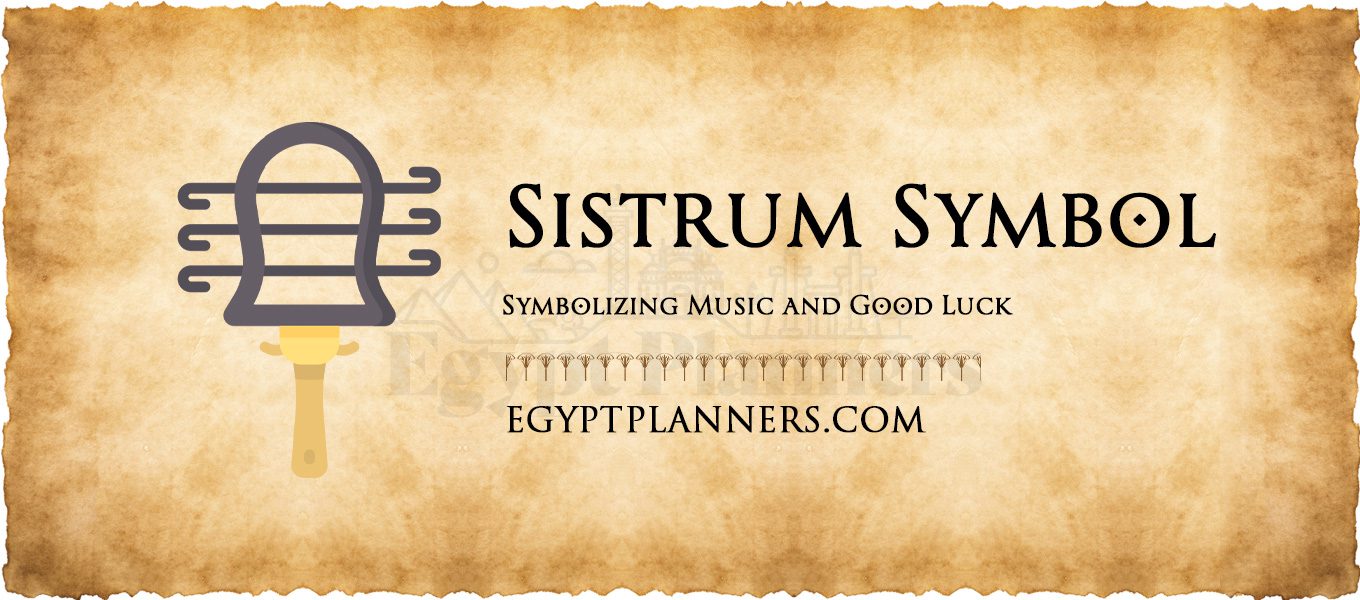
The Egyptian Sistrum, a musical instrument resembling a rattle, was used in religious ceremonies to ward off evil spirits and invoke the protection of the gods. Its distinctive sound was believed to please the gods, fostering a connection between the divine and the earthly realms. The Sistrum’s association with the goddess Hathor, patron of music and dance, highlights the instrument’s role in rituals of joy and celebration. This artifact reflects the ancient Egyptians’ belief in the power of music to transcend the mundane and connect with the divine, offering insights into their spiritual and cultural practices.
28- Nemyss: Egyptian Symbols of Protection
The Nemyss is a striped headcloth worn by pharaohs and deities in ancient Egypt, symbolizing royalty, divinity, and power. This distinctive headdress, often seen in statues and reliefs, served not only as a practical garment but also as a mark of high status and divine favor. The Nemyss underscores the importance of appearance and symbolism in conveying authority and maintaining the social and cosmic order. For modern observers, the Nemyss offers a tangible connection to the ancient Egyptians’ world, reflecting their values and the visual language they used to express them.
Don’t miss check out our related:
- Top 30 Important Ancient Egyptian Symbols
- Eye of Horus vs Eye of Ra
- Anubis Egyptian Dog God
- 42 Ancient Egyptian Amulets
- Egyptian Pharaohs
- Top 5 Egyptian Symbols for Power
- Top 8 Egyptian Symbols for Strength
- Top 15 Ancient Egyptian Good Luck Symbols
- Revered Animals in Ancient Egypt NYT
- List of Egyptian Queen Names
- Ancient Egyptian Goddess Bastet
